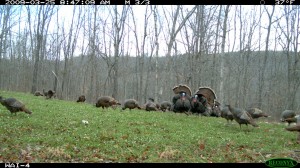How Do I Create Hidey Hole Food Plots?
Grant,
On one of my small metro area properties I have 2 areas within the woods that I plan to food plot this year. Each area is about a 1/2 acre – 3/4 acre in size. Right now the canopy is open and I will not have to do much clearing, so I think it will be a great place to do some growing. Currently it is just grass that gets about knee to thigh high by mid-summer. For my first year what would be the best way to plant and manage these areas? Should I spray it and plant it early or should I spray it multiple times and do a late summer planting? I have a couple ideas but I am curious what you think. This particular property is only 20 acres and there are some very nice mature deer around. The problem is that I do not have the food source on this property to drive them in. During the summer if I put corn down in front of the camera I can almost guarantee that I will get a few pics of mature bucks. But once the corn is gone I am not seeing them on the property at all. They are close and I think that the plots may help me a lot next fall. Given the little information that I have given you here, what are your thoughts?
Thanks in advance!
Tim
Tim,
Your observations indicate that food is a limiting resource in your area. Except in areas with production ag, quality food is usually in short supply and serves as a great attractant for deer. Combine quality food with limited human disturbance and you have a Hidey Hole (code name for my preferred place to hunt)!
To create a Hidey Hole in the conditions you described, use any method to remove the duff (dead grass, leaves, etc.). On larger scale projects in non urban areas, fire is a great tool. For some of my Hidey Hole plots, I use a rake and backpack leaf blower. Once the duff is removed and the remaining vegetation is growing, spray with Glyphosate to kill the competition. If the duff is removed, and the vegetation is putting on new growth, one application of herbicide is usually enough.
Then fertilize appropriately for the crop you wish to plant. Forage soybeans are extremely palatable and browse resistant. Soybeans germinate best when covered with soil, so they are a bit more difficult to plant in a Hidey Hole situation than smaller size that can be broadcast. However, they are a great early season attractant!! They will be killed by the first frost. If your goal is simply to attract deer later than the first frost to that location, mix some wheat with the soybeans and plant a month before archery season opens. Deer love young soybeans, and the wheat that will jump after the beans have been consumed or killed by the first frost. If your goal is to create an attraction plot to hunt during early, mid, and late season, mix in some brassicas as they will usually be more of an attractant later in the season. Clover is slow to produce much volume, so don’t count it as an attractant during the first season. However, it is a great attractant the following spring — if you like to turkey hunt! Turkey’s readily convert Hidey Holes in to strut zones.
If your goal is to create an attraction plot to hunt during early, mid, and late season, mix in some brassicas as they will usually be more of an attractant later in the season. Clover is slow to produce much volume, so don’t count it as an attractant during the first season. However, it is a great attractant the following spring — if you like to turkey hunt! Turkey’s readily convert Hidey Holes in to strut zones.
Hidey Holes are a great tool that can be established with some labor, but not much cost in seed and equipment.
Growing Deer together,
Grant
🔗 Link | ↑ Top



 If your goal is to create an attraction plot to hunt during early, mid, and late season, mix in some brassicas as they will usually be more of an attractant later in the season. Clover is slow to produce much volume, so don’t count it as an attractant during the first season. However, it is a great attractant the following spring — if you like to turkey hunt! Turkey’s readily convert Hidey Holes in to strut zones.
If your goal is to create an attraction plot to hunt during early, mid, and late season, mix in some brassicas as they will usually be more of an attractant later in the season. Clover is slow to produce much volume, so don’t count it as an attractant during the first season. However, it is a great attractant the following spring — if you like to turkey hunt! Turkey’s readily convert Hidey Holes in to strut zones.